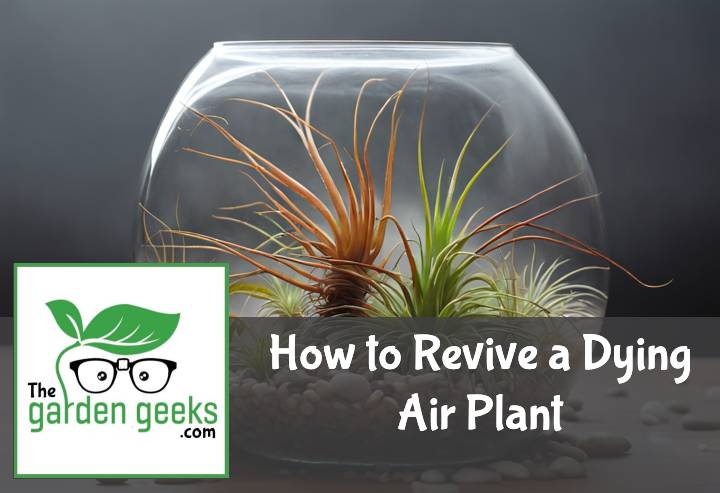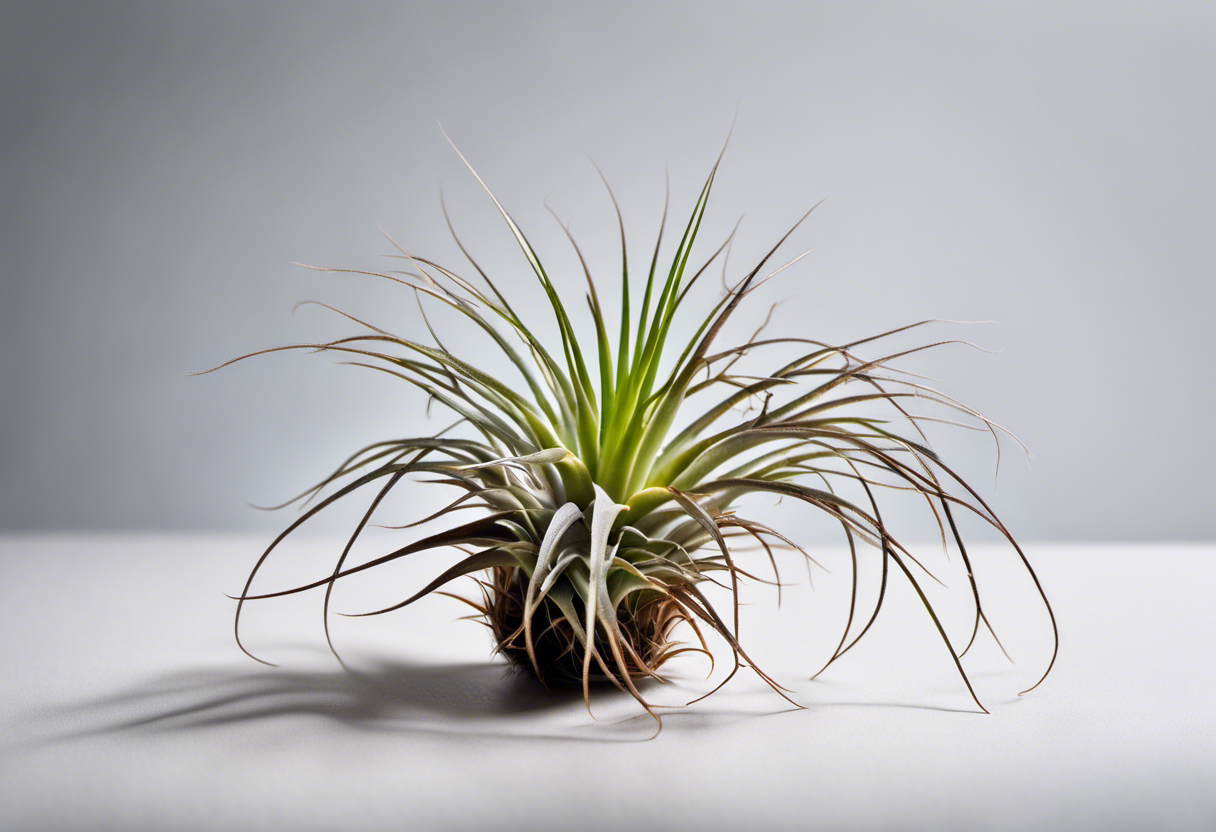Ever found yourself standing in front of your leafy friend, wondering How to Revive a Dying Air Plant? Trust me, I’ve been there, and it feels like a botanic crime scene. You know, the kind where you’re both the detective and the prime suspect.
But don’t fret! Even if your green thumb feels more like a grim reaper’s touch lately, I’m here to assure you that there’s hope. So put down that shovel – we ain’t digging any plant graves today! Keep reading about How to Revive a Dying Air Plant.
Key Takeaways
- Identify signs of a dying air plant such as brown or yellow leaves, and a soft or rotten base.
- Increase watering if the plant is under-watered. Soak it in water for 30 minutes to an hour every week.
- Reduce watering if the plant is over-watered. Let it dry completely before the next watering.
- Provide indirect sunlight. Too much direct sunlight can burn the plant.
- Maintain proper temperature between 50 and 90 degrees Fahrenheit.
- Use a fertilizer designed for air plants once a month.
Understanding Air Plants
Air plants, my friends, are the rebels of the plant world. They’ve got a unique vibe that sets them apart from your typical potted pals. These little green wonders have become quite popular for their low-maintenance lifestyle and distinctive characteristics. So, buckle up as we dive into the air plants basics and explore why these bad boys might kick the bucket.
What are Air Plants?
Air plants, or Tillandsia if you want to get scientific about it, are a bit of an oddity in the plant kingdom. They’re like the hipsters of houseplants – they don’t need soil to survive! Instead, they prefer to hang out in trees or rocks in their natural habitat. This makes them different from other houseplants which rely on soil for nutrients. So remember folks, when it comes to air plants, it’s all about that free-living lifestyle!
Why do Air Plants Die?
Now onto the sad part – why do these cool cats sometimes bite the dust? The most common culprits are improper watering and lighting conditions. Too much love (read: water) can actually drown these guys! And not enough light can leave them feeling pretty blue too. Look out for signs like browning leaves or a droopy appearance – this could mean your air plant is on its way to plant heaven. But don’t worry! We’ll soon learn how to revive a dying air plant in upcoming sections.
Identifying a Dying Air Plant
Knowing when your air plant is on the brink of death is crucial. It’s all about early detection, folks! Air plant care isn’t rocket science, but it does require a keen eye for dying air plant symptoms. The sooner you spot trouble, the better your chances of reviving air plants back to their prime.
Signs of a Healthy vs. Dying Air Plant
Let’s talk about what a healthy air plant looks like first. They’re usually vibrant in color, with firm leaves that stand tall and proud. If your plant has these healthy air plant signs, give yourself a pat on the back!
On the flip side, if your green buddy starts showing brown or yellow leaves, it might be sending out an SOS. These are classic dying air plant indicators. Also, if the leaves feel soft or mushy instead of firm, it’s time to switch on your indoor gardening superhero mode.
Common Problems with Air Plants
Air plants can be drama queens sometimes! They’re prone to certain issues that can lead to their downfall if not addressed promptly. Overwatering is one such common problem in air plant care that often leads to rotting – yikes!
Another frequent issue is inadequate light. Yes, these little guys love their sunlight! Lack of proper light can make them weak and susceptible to diseases.
And let’s not forget about temperature and humidity levels – too high or too low can spell disaster for these delicate creatures. So keep an eye out for these common indoor plant issues, and you’ll be well on your way towards maintaining healthy air plants and mastering the art of how to revive a dying air plant!
Steps to Revive a Dying Air Plant
Reviving a dying air plant is like playing detective. You gotta figure out what’s going wrong, then take steps to fix it. Let’s dive into the nitty-gritty of how to revive a dying air plant.
Assessing the Condition of the Plant
First things first, you gotta assess the health of your air plant. Look for signs of distress like browning tips or limp leaves. If it’s looking more like a dried-up tumbleweed than a lush green beauty, you’ve got an unhealthy air plant on your hands.
Next step in our air plant revival steps, is to check if the leaves are curling inward. This could mean your little green buddy is thirsty and needs water pronto! On the other hand, if the base is brown and mushy, that’s a sign of overwatering.
Correcting Watering Issues
Now let’s talk about H2O. Watering issues are often at the root (pun intended) of air plant problems. So how do we correct this? Well, if you’re underwatering your plant, start by giving it a good soak.
If you’re dealing with an overwatered plant though, hold off on watering for now. Let it dry out completely before giving it another drink. Remember folks, balance is key when it comes to proper hydration for air plants!
Adjusting Light and Temperature Conditions
Last but definitely not least, let’s chat about light and temperature conditions. Your air plant needs plenty of indirect sunlight – think bright but not blinding! Too much direct sun can cause sunburn (yes, plants can get sunburn too!).
As for temperature, keep your green pal in a space that stays between 50-90°F (10-32°C). Anything colder or hotter could send your plant into shock. So, adjust those light and heat conditions for your plant’s comfort and watch it bounce back to life!
Maintenance Tips for Healthy Air Plants
Alright, folks! Let’s dive into the nitty-gritty of air plant care. It’s not rocket science, but it does require a bit of TLC (Tender Love and Care). We’re talking about watering practices and finding that Goldilocks zone for light and temperature. Stick with me, and you’ll be an air plant maintenance guide guru in no time!
Ideal Watering Practices for Air Plants
Now, onto the juicy stuff – watering your air plants. You might think, “It’s just water, how hard can it be?” Well, let me tell you, there’s a science to this! The frequency and method of watering air plants can make or break their health.
So here’s the scoop: air plants aren’t cacti. They need more than a sprinkle now and then. But don’t go all Niagara Falls on them either! Overwatering is a real thing and trust me; it ain’t pretty. Look out for signs like yellow leaves or a rotten smell – these are classic symptoms of an overwatered air plant.
On the flip side, underwatering isn’t great either. If your plant looks shriveled or has brown tips, you might be dealing with an underwatered air plant. Remember folks; balance is key!
Optimal Light and Temperature for Air Plants
Moving on to our next topic: light conditions and temperature control. This part is crucial in maintaining healthy air plants.
First off, let’s talk about light requirements. Your air plant doesn’t need to sunbathe all day long but don’t keep it in the dark either! Aim for bright but indirect sunlight exposure – think of it as their SPF protection against getting sunburnt.
Temperature-wise, these little guys prefer something akin to a mild spring day – not too hot, not too cold. The best temperature for air plants is around 50-90°F (10-32°C). Anything more or less might send them into plant shock.
And there you have it! That’s your crash course on how to revive a dying air plant. Remember, it’s all about balance and giving your plant the right conditions to thrive. Keep these tips in mind, and you’ll be an air plant whisperer in no time!
To Wrap Up
Think of your air plant as a delicate, leafy ballerina: it needs just the right amount of light and water to perform its best. We’ve shown you How to Revive a Dying Air Plant with some TLC and patience.
In the end, remember that plants are like silent pets. They can’t tell you what’s wrong, so keep an eye on them and be their voice. Your air plant will thank you with lush growth!





